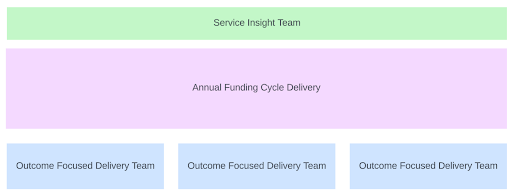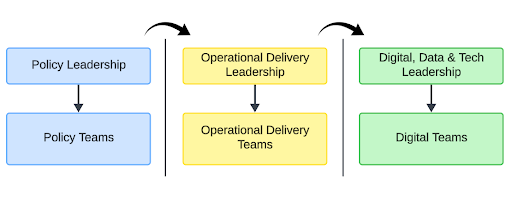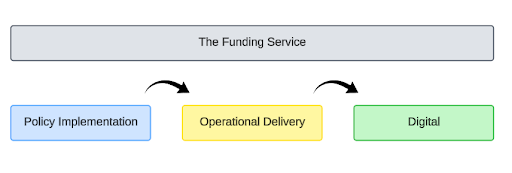Mission driven Government
Published on
My take on mission driven government and how we can move towards this way of working from within our current policy inspired structures.
Published on
My take on mission driven government and how we can move towards this way of working from within our current policy inspired structures.
Published on
With the shift towards mission-driven initiatives, we have a huge opportunity to rethink how we approach service delivery across the public sector. As long as I’ve been a Civil Servant, the idea of delivering "whole services" has been a regular topic of conversation but moving things from theory or discussions to reality has been slow. Why? Because services or user journeys, defined as they are experienced by users, cut across multiple teams, directorates, and even departments. These cross cutting services simply do not fit into the internal or policy focused teams and structures we work in.
Mission-centred Government aims to fix this by uniting people around shared problem spaces to achieve better outcomes for service users. It relies on multidisciplinary teams and the breaking down of silos. These teams must operate at different levels within the organisation, requiring increasing autonomy and trust as they scale. To build that trust, we need to start small, embed standards and ways of working through delivery and expand outward and upward.
It makes sense to start with the areas within our control or where the design and research skills needed are positioned. We need to reshape our digital teams to enable them to focus on service outcomes and user journeys instead of single interactions. Too often digital teams are constrained by internal structures or tasked with creating online versions of existing processes.
In my current role working on the Education and Skills Funding Service, which funds 25,000 providers and delivers £84bn annually, we've been working on this transformation. Originally, our digital teams and systems mirrored internal processes and structures, this setup hindered our ability to tackle service-wide problems and to respond quickly to new policy or changing priorities.

To address this, we re-integrated research and design skills into our delivery teams, making them true multidisciplinary teams. We added a service insight team to look across the whole service without being constrained by existing team boundaries or systems. And we created outcome-focused teams to tackle service wide problem spaces, such as improving funding communication and more efficiently onboarding new funding streams.

This approach enables the work of user researchers to actively inform our decisions instead of validating existing ideas. It also allows designers to think more creatively about how we might solve problems instead of finding the best way to implement pre defined solutions.
This model also allows us to be more flexible and to react quickly to policy changes by having teams outside of defined pieces of technology. We can also start to prioritise work across the entire service making sure we are working on the right things at the right time.
As part of our team structure work, we brought the individual product teams responsible for the annual funding cycle closer together. This shift helps us view business-as-usual delivery as a whole service rather than six separate products, leading to more streamlined delivery and an opportunity to shift the things we measure from single interactions to the overall service goal. To help with this we also introduced a user experience survey to better understand how effectively we support users in securing the correct funding. The survey gathers feedback on key aspects of the user experience, such as clarity about how much funding their organisation will receive and when, helping us measure progress toward our strategic objectives.
We are shifting from funding projects with specific technology requirements to funding teams that deliver continuous value. To achieve this we also needed to change how we frame and report on work. We started by creating a more outcome focused business case and statements of work, moving from specific targets and systems to build to measurable benefits like communicating funding decisions in a way that meets the needs of our users and is cost effective to deliver year on year.
We are also changing how we engage suppliers. Our new contracts will support our new team structure, with one focusing on running and refining the existing funding service and the other on improving and growing it, aiming to increase the number of grants we can deliver through innovation and transformation. Splitting things out this way allows us to put resources where they are needed throughout the funding year instead of aligning people to systems.
The Funding Service encompasses all the processes, tasks, and interactions required for education providers to receive their annual funding. This goes beyond the work and influence of digital teams which often sit under separate reporting lines.
Influencing all parts of service delivery like this from within the Digital, Data, and Technology (DDT) bubble can be challenging. In my previous roles I struggled because I was part of a separate directorate with separate reporting lines, and differing ideas on purpose or mission. Digital was seen as a team to instruct rather than one to involve in decision-making.

The best thing about the service I now work on is that this isn’t the case. We have an embedded model with the digital team working side by side with the operational delivery and policy implementation teams.

This model addresses the issue of separate reporting lines by establishing a true service owner in the Director of Funding role. A role that oversees the entire service, including digital delivery. For the digital team, this gets us much closer to the decision making space, creates a whole team approach and allows us to be proactively involved in things like developing the service strategy.
However, embedding digital functions alone isn't a guaranteed fix. There are still handover points from team to team with digital teams often the last step in the chain. This still leads to fragmented services and digital teams that are handed solutions to build instead of problems to solve. To increase our ability to deliver efficient and effective services we again need to utilise multidisciplinary teams this time including roles outside of the digital directorate to work horizontally across the whole service.

By bringing research and design skills further upstream to work alongside operational delivery and policy implementation we can take a broader view of the problems we need to solve and make more informed decisions based on the needs of our users. Many of the barriers or challenges to working this way stem from differing interpretations or definitions of digital delivery. To some, digital still means IT systems, portals or websites so our first step towards changing ways of working was to define what we mean when we say digital and then repeat it as often as possible. The definition we use is:
Digital transformation is a way of working that involves multidisciplinary teams leveraging data and research insight to improve business processes, achieve shared outcomes, and deliver incremental value.
There's also differing methodologies at play. My experience of working with operational delivery and policy teams in the past is more aligned to waterfall project delivery, based on a series of requirements and tracked with milestones. In digital, we talk a lot about funding teams and not projects, which is what we are doing with our outcome delivery teams. If we want to scale that approach outside of digital we need to show the benefits different ways of working can bring. We have started to do this firstly by integrating service design skills earlier in the process of deciding how we could deliver a new grant. This collaboration helped us to take a service wide approach to the work and to use insight from each team to create a series of options that could be evaluated. On the back of this work we have planned more collaborative projects to improve grant onboarding and enhance our communication with the sector.
The funding service is a service in its own right with the mission to ensure that the right amount of education funding reaches the right place at the right time, providing certainty to providers and maximising their impact on learners. However mission driven government should be about more than that, the mission level is about the reason behind the funding, the policy intent for each grant and how success against that intent is measured. This goes way beyond the control of any single service owner; it crosses multiple teams and departmental boundaries.
There has been much discussion about service owners and creating roles accountable for whole service outcomes. While this is working well for us on the Funding Service, a broader mission requires a role that holds accountability across multiple directorates. Creating a role like this could be a significant step forward, however creating a role responsible for the delivery of a mission that sits outside of existing structures may create a layer of separation between them and the decision-making processes they need to influence. Instead, we could focus on how multiple roles can work together across the existing internal structures, collaborating to achieve common goals.
The mission layer or top-level user journey should provide the outside-in perspective and help us to define measures of success that can be used to encourage collaboration through alignment to a shared goal. These are bigger than the metrics we use to track the delivery of funding which also serve governance and reporting. Mission-based Government should also shift the narrative away from short term incentives and the desire for quick wins allowing teams to focus on the more strategic objectives. To really shift that mindset we need to eliminate the competitive nature of product or sub-service specific KPIs that can pit portfolios or directorates against each other, instead incentivising collaboration. We also need to be braver with delivery timelines and goals. It's important to take a broader view to make sure we are solving the right problems at the right time, stopping or pausing delivery where needed to ensure consistency. Doing the right work at the wrong time isn't enough; we need to maximise impact by aligning delivery across departments.
To understand how and where we should work together we need to visualise these top level user journeys, mapping interactions as they happen across departments, surfacing handover points to enable us to design and deliver more cohesive services. Having more people from design or product backgrounds in leadership roles can help with this as well as helping us to properly establish design outside of digital teams. This would help us to move away from digitising existing processes towards real transformation. In Funding we are at the very start of this journey, we are building a team and operating model capable of working in this way whilst also maintaining our business as usual delivery.
In conclusion, mission-centred Government is about designing smarter ways to work together enabling us to deliver better outcomes for users. The immediate challenge is finding ways to do this from within our current structures which are not aligned to services.
To succeed, we need a new mindset: one that prioritises collaboration over silos and outcomes over outputs. This shift isn’t just about digital or technology, it’s about reimagining how we work together to solve shared problems. We need multidisciplinary teams that operate at every level of the organisation, bringing operations, policy and digital together to make the most of the differing skill sets and expertise.
The longer term goal should be to design organisations around the services they provide, enabling true service owner roles to exist at every service level. A big enabler to this is creating more design roles inside policy and operational divisions. This is already starting to happen with conversations across Government about what a future SCS level design role should look like and the responsibilities and autonomy that role should hold. There are also large departments designing operational roles centred around how we surface user journeys and use them to help us deliver better services.